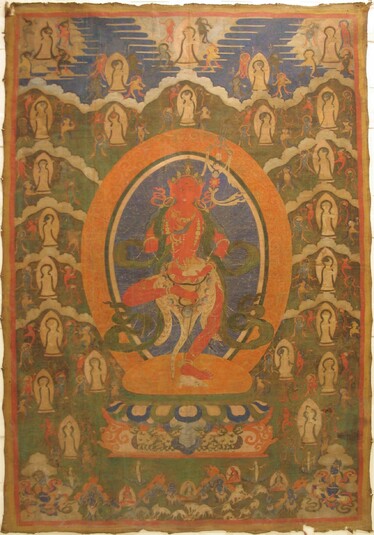
Item: Khandroma (Bon Deity)
| Origin Location | Tibet |
|---|---|
| Date Range | 1800 - 1899 |
| Lineages | Bon |
| Material | Ground Mineral Pigment on Cotton |
| Collection | Rubin Museum of Art |
Classification: Deity
Kandroma Marmo (English: The Red Sky Goer) from the Magyu Sangchog Tartug System of Bon Tantra. Bon Tantra is divided into two divisions, Mother and Father. Magyu is the principal system of the Mother Tantra.
Kandroma is a red goddess with one face and two hands, holding in the right hand a curved knife and a skullcup in the left. A tantric staff rests against the left shoulder and she stands in a dancing posture atop a sun disc, lotus blossom and a throne supported by multiple snow lions.
Surrounding the central figure are one hundred and twenty attendant figures arranged in groups of five. There are twenty-four groupings of five figures each, all with animal heads and coloured white in the center, with red, green, yellow and blue surrounding.
At the bottom right and left are two of the Four Guardian Kings of the Bon tradition. Between these two are cemetary scenes with wrathful spirits, nagas, fires, wild animals and corpses. In the Magyu tradition of spiritual practice the Kandroma form is used in the many ancillary practices such as symbolically offering the body, dream yoga, heat yoga etc.
The identifying indicators establishing this painting as a Bon deity are principally the left turning yungdrung (svastika) emblem adorning the Tantric staff, the body posture with the right hand placed in front of the chest, the multiple snow lion supported throne and the groupings of five deities repeated around the central figure. Clustering attendant figures in coherent groups is a compositional characteristic found in Bon art.
The iconography of this painting is unusual in that the central Kandroma is holding a curved knife with a vajra handle in the right hand. The vajra is typically a Tantric Buddhist symbol and not commonly found in the Bon religion. There was however a Bon reform movement call the New Bon (Bon Sarma) that borrowed heavily from the Nyingma Tradition of Tibetan Buddhism. This painting is likely influenced by the New Bon movement, or an artist familiar with the symbols of the Nyingma. The red and yellow painted border is typical of paintings created in the Amdo area of East Tibet.
Jeff Watt 8-2006
Front of Painting
English Translation of Inscription: There are no inscriptions on the front or back.
Collection of Rubin Museum of Art: Painting Gallery 4
Painting Style: Bon Art in Amdo
Bon Deity: Kandroma
Collection of Rubin Museum of Art: Bon Artworks


